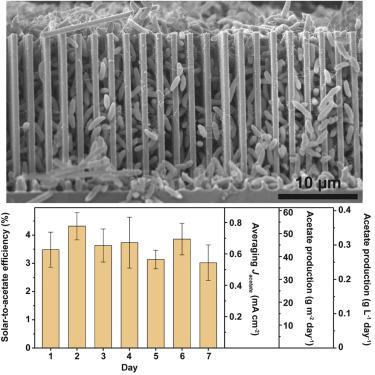Joule ( IF 38.6 ) Pub Date : 2020-03-31 , DOI: 10.1016/j.joule.2020.03.001 Yude Su , Stefano Cestellos-Blanco , Ji Min Kim , Yue-xiao Shen , Qiao Kong , Dylan Lu , Chong Liu , Hao Zhang , Yuhong Cao , Peidong Yang

|
Microbial electro- and photo-electrochemical CO2 fixation, in which CO2-reducing microorganisms are directly interfaced with a cathode material, represent promising approaches for sustainable fuel production. Although considerable efforts have been invested to optimize microorganism species and electrode materials, the microorganism-cathode interface has not been systematically studied. Here, investigation of the interface allowed us to optimize the CO2-reducing rate of silicon nanowire/Sporomusa ovata system. Tuning the bulk electrolyte pH and increasing its buffering capacity supported the formation of a close-packed nanowire-bacteria cathode. Consequently, the resulting close-packed biohybrid achieved a CO2-reducing current density of ∼0.65 mA cm−2. When coupled with a photovoltaic device, our system enabled solar-to-acetate production with ∼3.6% efficiency over 7 days.
中文翻译:

紧凑包装的纳米线-细菌杂合体,可有效地驱动太阳能驱动的CO 2固定
微生物电化学和光电化学CO 2固定(其中还原CO 2的微生物直接与阴极材料接触)代表了可持续燃料生产的有前途的方法。尽管已投入大量精力来优化微生物种类和电极材料,但尚未系统地研究微生物-阴极界面。在这里,对界面的研究使我们能够优化硅纳米线/卵形孢子体系统的CO 2降低率。调节整体电解质的pH值并增加其缓冲能力有助于形成密堆积的纳米线-细菌阴极。因此,所产生的紧密包装的生物杂化物获得了CO 2。降低的电流密度约为0.65 mA cm -2。当与光伏设备结合使用时,我们的系统可以在7天内以约3.6%的效率生产太阳能醋酸盐。











































 京公网安备 11010802027423号
京公网安备 11010802027423号